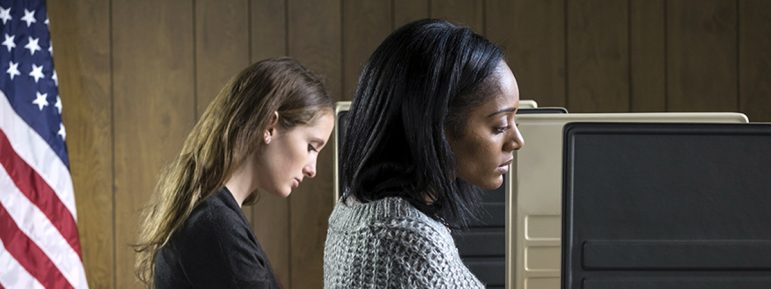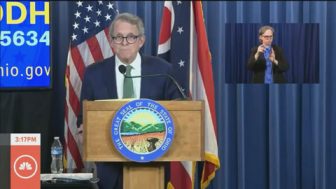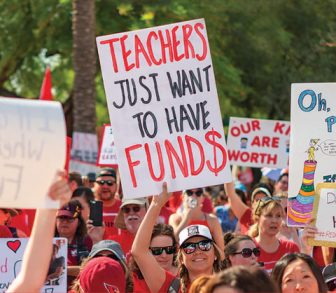Doing Whatever It Takes: A Changed Perspective
By Julie Holderbaum, Minerva EA/OEA
Henry Darby, a principal in South Carolina, recently made headlines for working an overnight job at Walmart so he would have extra money to help the students in his community. Why? According to Darby, “You just…do what you need to do.”1
I think I’m supposed to have warm, gooey feelings when I hear about stories like his, so why did it depress me so much?
Maybe because this year, I have had little energy to do much beyond show up to work on time and put forth a solid effort during the day. I leave as soon as I am contractually allowed to leave, and outside of a few weekend afternoons grading at home, I’ve not spent time doing school work after 2:30 PM each weekday.
 It didn’t used to be this way. Like Mr. Darby, I would do whatever it took to get the job done and done well, even if that meant grading or planning in my home office instead of spending time with family, or spending my own money on supplies for my students. Even when not in school, it was not unusual for my brain to be constantly whirring with thoughts of lesson plans or students or activities or curriculum pacing or technology or state tests or any of the countless number of aspects to a teacher’s job.
It didn’t used to be this way. Like Mr. Darby, I would do whatever it took to get the job done and done well, even if that meant grading or planning in my home office instead of spending time with family, or spending my own money on supplies for my students. Even when not in school, it was not unusual for my brain to be constantly whirring with thoughts of lesson plans or students or activities or curriculum pacing or technology or state tests or any of the countless number of aspects to a teacher’s job.
But this year, I’ve started to wonder if I have the energy to make it to retirement in a teaching career. National news stories heralding extraordinary educators like Mr. Darby only make me question myself even more. A few times, I’ve caught myself wondering if it’s time to consider getting out.
I’ve come to realize, though, that in spite of the stress of teaching through COVID, I still have what’s most essential to being a good teacher: I still care about the kids.
Of course I get frustrated with my high school students at times. But the fact remains, I want them to become flourishing adults who contribute meaningfully to their communities. I want them to be able to think and read critically, to fight with passion for their beliefs and to listen with compassion to those who hold opposing points of view. I want them to recognize the importance of finding the balance between living every day as if it’s their last and as if they will live forever. I want them to learn to approach each day with intention, putting forth an effort they can be proud of, even if the day consists of the mundane routine of going to school and home again.
Those desires fuel every lesson I plan, even this year, when literally surviving is my main goal.
When the pandemic hit almost a year ago and we had to start teaching from home, I learned very quickly that I was going to have to work to keep my anxiety at bay. I exercised daily. I read for enjoyment. I did yoga. My family and I worked puzzles. I watched the news only once per day and limited my time on social media.
When school started this fall, my district decided to go back face-to-face, five days a week. I’ve had to keep up the practices I started last spring in order to take care of my mental well-being. Consequently, I’ve had no extra time to put into my job, and frankly, the stress of being in school saps my energy for even thinking about school when I’m not there.
One of the newscasters telling Mr. Darby’s story wondered when he had time to sleep. It’s a good question; what he is doing is most likely not sustainable for a long period of time, no matter the depths of his love for his students. We need to realize that teaching is an exhausting job whether we are experiencing a pandemic or not, and whatever we do to get the job done needs to be something we can continue to do for the long haul.
 I am not questioning Mr. Darby for working that second job, nor am I criticizing teachers who grade papers on the weekends or stay late after school or provide supplies for their students. We need people like that. But maybe we need to take turns being people like that. And we need to recognize that it’s okay not to be people like that.
I am not questioning Mr. Darby for working that second job, nor am I criticizing teachers who grade papers on the weekends or stay late after school or provide supplies for their students. We need people like that. But maybe we need to take turns being people like that. And we need to recognize that it’s okay not to be people like that.
Maybe we need to question why teachers feel pressured to sacrifice whole chunks of their lives to their job outside of regular work hours.
Maybe we need to question why teachers who take care of their own mental health aren’t as highly glorified in the media as teachers who run themselves ragged trying to make up for the shortcomings of our society. Where are the stories about teachers who figure out how to leave school at school, who work like dogs during the day so they can come home at night and hit the mat for some downward dogs?
Maybe we need to question why, in 2021, in any state in this country, funding for public schools is so egregiously inadequate that a principal would even consider getting a second job to make more money to provide for his students. We certainly need to question why here in Ohio, our legislators just can’t ever quite get around to fixing our state’s unconstitutional school funding system. What are our legislators prioritizing over our kids? And why?
Society has always faced more questions than answers when it comes to dealing with public education, but this year, the question that has haunted me is whether or not it’s time to leave education. To answer that question, I had to ask another: do I want to continue to be an educator? The answer is a resounding yes, so I must do whatever it takes to allow myself to keep showing up for those teenagers who I still care about so much.
 COVID has changed the way every American is able to perform their job, whether that job is in a hospital or a grocery store or an office or a classroom. We are all facing situations for which we have not been trained or adequately prepared. Teachers certainly aren’t the only ones dealing with higher levels of stress than usual. But society has always asked teachers to live up to extraordinary expectations, and we aren’t all Louanne Johnson or Erin Gruwell; being a good teacher, even an exceptional teacher, doesn’t always mean accomplishing feats that are big-screen worthy.
COVID has changed the way every American is able to perform their job, whether that job is in a hospital or a grocery store or an office or a classroom. We are all facing situations for which we have not been trained or adequately prepared. Teachers certainly aren’t the only ones dealing with higher levels of stress than usual. But society has always asked teachers to live up to extraordinary expectations, and we aren’t all Louanne Johnson or Erin Gruwell; being a good teacher, even an exceptional teacher, doesn’t always mean accomplishing feats that are big-screen worthy.
For many years of my career, “you do what you gotta do,” meant doing whatever it took to get my job done. Now, it means doing whatever I have to do to take care of myself physically, mentally, and emotionally, and not letting my job or the stress that comes with it overtake the rest of my life.
During a pandemic or during a “normal” year, if you’re doing your job as well as you can within school hours and then letting it go, it’s okay. We can’t possibly hope to produce flourishing students if we aren’t even attempting to flourish ourselves. Sometimes you don’t do what you gotta do to get the job done; you do what you gotta do so that you can keep doing the job.
— Julie Holderbaum is an English Instructor and an Academic Challenge Advisor at Minerva High School, Minerva, Ohio.
[1]High school principal works overnight at Walmart to … – Yahoo News.” 29 Jan. 2021, https://news.yahoo.com/high-school-principal-works-overnight-153343899.html. Accessed 2 Feb. 2021
To Vote or Not to Vote: Why Educators Need to Do More Than Help Students Register to Vote
By Julie Holderbaum, Minerva EA/OEA

On a recent visit home, my 22-year old stepdaughter told me that she wasn’t planning to vote this year, and then she admitted that she never had before, either.
As we talked, two reasons for this came to light. Apathy was not one of them. Instead, not knowing what to expect at the polls, not knowing which local candidates would be on the ballot, and feeling that her vote wouldn’t matter anyway were enough to silence her voice.
She expressed that she was really nervous to go to the polling place because she had no idea what to expect. I have always emphasized the importance of registering to vote to my students. I’ve even helped register several voters in my classes of juniors. But in my haste to register my students to vote, it never occurred to me to explain to them what the actual act of voting would be like.
She wasn’t too worried about not going to vote since the 2016 election convinced my stepdaughter that her vote wouldn’t matter anyway. I can see why she felt that way; Hillary Clinton won the popular vote by 3 million votes but lost the election because she came up short in the electoral college. The fact is, however, that history is replete with elections decided by one or a very few votes. In Vermont in 2016, both a state Senate Democratic primary and a state House seat were determined by one vote[1], and several presidential elections have been narrowly decided as well[2].
My stepdaughter’s revelation to me was heartbreaking. I hated the thought of her not exercising the right that so many people fought so hard to get, the right that gives her a voice in choosing the values and policies of the community and country she lives in.
Many educators discuss the importance of voting with our students. But can we do more to alleviate their anxiety and fear of the unknown, to make them feel that their voice matters? I think we can.
- Share your first time voting story. You don’t have to disclose who you voted for to tell students about where you were and how you felt. Did you vote in person or absentee? Did you feel prepared to vote? What did it feel like if you didn’t know anything about candidates on the ballot? I tell them how I’ve felt when I’ve seen names on a ballot in local races and not known anything about them: do I pick one at random or do I not vote in that race? One seems risky and the other seems disrespectful to all those who have fought for my right to vote. I also tell them that it feels so much better to know I have done the research and am voting for a person (or issue) with intention.
- Explain the voting process. Encourage them to let the poll workers know it is their first time voting; most likely, they will be excited and happy to help them navigate each step of the process. Tell them that they will show their ID and it will be scanned, and they will sign either a paper or an electronic keypad. They will be directed to the voting booth, which may or may not have a curtain like the voting scenes on TV always seem to. They may vote on a computer. They might be given a paper ballot and a pen to bubble in their choice. They may be given a punch card to indicate their choices. Tell them that they do not have to vote in every race on the ballot. Whatever the method, reassure them that it will be private and no one will see how they vote. Discuss the importance of completing absentee ballots thoroughly and correctly, and following all directions precisely.
 Discuss the history of the fight for suffrage in America. Only 6% of Americans were eligible to vote in the first presidential election.[3] The other 94% had to fight to get the right to participate in democracy in America. Read articles and show movies about efforts to get the right to vote and the obstacles that still impede efforts to vote for so many Americans. The 2020 Amazon Prime documentary All In: The Fight for Democracy is excellent and gives a history of voting rights and suppression efforts in America. (Preview any film before showing your classes).
Discuss the history of the fight for suffrage in America. Only 6% of Americans were eligible to vote in the first presidential election.[3] The other 94% had to fight to get the right to participate in democracy in America. Read articles and show movies about efforts to get the right to vote and the obstacles that still impede efforts to vote for so many Americans. The 2020 Amazon Prime documentary All In: The Fight for Democracy is excellent and gives a history of voting rights and suppression efforts in America. (Preview any film before showing your classes).- Impress upon your students that every vote counts. Read about elections that came down to just a few votes. Share the fact that studies show more people vote when they know lots of other people are voting. Tell your students that publicizing they are voting can remind and encourage others to vote…and all of those votes will certainly have an impact.[4]
- Demonstrate how to find information about the candidates, registration, and polling places. Today’s young voters have advantages that I did not when I first voted. Websites for each state’s Secretary of State and County Boards of Elections have information about how to check if your voter registration is up to date and more. The Ohio Voter Info app [5] allows users to see a sample ballot, making it easy to research the candidates and issues before going to the poll. The app also allows users to check absentee ballot status, see where their polling place is, and view election results. When We All Vote is another great resource, and the website has a toolkit for schools to teach kids of all ages about voting.[6]
- Build excitement for future voting in children. What if we could get kids to look forward to their first time voting as much as they look forward to getting a driver’s license or going to prom? If we start talking about voting with young children, I think we can build a level of excitement and appreciation for the right to vote. There are books for all ages of children that address elections and voting.[7] Make them part of your classroom library.
Along the same lines, take your own children with you when you vote. I have taken my daughter with me since she was four years old, and every time, I have explained to her who I am voting for and why. The familiarity with the voting process has become ingrained in her. Encourage your students to ask their parents if they can go with them the next time they vote so they can see the process of voting in action.

Political conversations in the classroom that promote issues or candidates are never appropriate, but the act of voting is not a partisan issue. It is our duty as educators to prepare our students to become informed citizens who participate in the democratic process. We must remember, however, that it doesn’t matter how many students we register to vote; the only ones who have a voice are the ones who actually exercise that right. We need to go beyond registration efforts and address the concerns and fears young voters have about the actual act of voting.
During that infamous visit, my stepdaughter and I updated her voter registration and downloaded the Ohio Voter Info app. She knows where she is going to vote and which issues and candidates will be on her ballot. She’s ready to vote in one of the most historic elections in American history this November.
The best part? The next time she came home to visit, she had another announcement to make: “You’re going to be so proud of me. I helped my roommate register to vote.”
— Julie Holderbaum is an English Instructor and an Academic Challenge Advisor at Minerva High School, Minerva, Ohio.
[1]Close Elections: Why Every Vote Matters : NPR.” 3 Nov. 2018, https://www.npr.org/2018/11/03/663709392/why-every-vote-matters-the-elections-decided-by-a-single-vote-or-a-little-more. Accessed 5 Oct. 2020.
[2]“5 Close US Presidential Elections That Prove Every Vote Matters.” https://www.globalcitizen.org/fr/content/why-every-vote-matters-closest-elections-in-histor/. Accessed 6 Oct. 2020.
[3] “Watch All In: The Fight for Democracy | Prime Video.” https://www.amazon.com/All-Fight-Democracy-Stacey-Abrams/dp/B08FRQQKD5. Accessed 6 Oct. 2020.
[4] “A better argument for why every vote matters – The Princetonian.” 11 Oct. 2018, https://www.dailyprincetonian.com/article/2018/10/a-better-argument-for-why-every-vote-matters. Accessed 5 Oct. 2020.
[5] “Ohio Voter Information – Apps on Google Play.” https://play.google.com/store/apps/details?id=com.triadgsi.dev.ohiovotes&hl=en. Accessed 6 Oct. 2020.
[6] “When We All Vote.” https://www.whenweallvote.org/. Accessed 6 Oct. 2020.
[7] “Kids’ Books About Elections and Voting | Scholastic | Parents.” https://www.scholastic.com/parents/books-and-reading/book-lists-and-recommendations/history-social-studies/election-books.html. Accessed 5 Oct. 2020.
Ohio Education Association Stands in Solidarity with Protestors Demanding an End to Systemic Racism and Brutality in wake of George Floyd’s Death
“George Floyd’s death at the hands of a Minneapolis police officer was horrific, and not merely an example of some ‘bad apple’ who should be prosecuted for murder, but symptomatic of a system that perpetuates brutality against people of color,” said OEA President Scott DiMauro. “We all share a responsibility to break the cycle of violence and systemic racism.”
OEA supports its members and their students who are expressing themselves through peaceful protests and adding their voices to the important national conversation about race and inequality sparked by Floyd’s death. “We have a unique responsibility as educators to fight against injustice,” DiMauro said. “Public schools are the place where we can learn to discuss issues without the fear of violence. The education system can help bring people together.”
The closing of schools that resulted from the COVID-19 pandemic has further exposed inequities in American society that are also symptomatic of the country’s racial disparities. “Only by addressing these deep-seated issues head-on can we ensure that all students are positioned for success, regardless of where they live or what they look like,” DiMauro said.
OEA calls on police forces to exercise restraint in their response to protestors who are working to bring about needed changes. “We need trauma-informed care, not suppression of mostly young activists,” DiMauro said. “We are saddened by how divided our communities are right now and by the destruction we’ve seen, but more than anything, we are saddened and outraged by what has caused this situation – a system that has disadvantaged and disenfranchised people of color in our country.”
“To those who have chosen to exploit this situation to sow destruction and provoke divisiveness in communities that are hurting, we say ‘shame on you’. To those who are non-violently protesting injustices and fighting to shape necessary reforms, OEA stands with you in solidarity,” DiMauro said.
In Senate Testimony, Ohio Education Association Urges Lawmakers to Prioritize Health and Safety in School Re-Opening Plans
“Schools will and should reopen when public health standards can be met. When that happens, we look forward to welcoming our students to a more equitable, safe and dynamic learning environment that meets the promise of public education that all students, parents, families and educators deserve,” DiMauro said.
DiMauro’s full testimony is available for reading at this link.
OEA has also provided advice to the Ohio Department of Education to help craft plans to safely re-open schools. OEA believes any decision on re-opening schools next year must be driven by guidance from public health officials, and any plan should include input from educators through local collective bargaining agreements and should provide flexibility to meet the needs of local school districts.
OEA represents 122,000 teachers, faculty members and support professionals who work in Ohio’s schools, colleges, and universities to help improve public education and the lives of Ohio’s children. OEA members provide professional services to benefit students, schools and the public in virtually every position needed to run Ohio’s schools.
‘A’ is for Advocacy – Why We Must All Become Activist Educators
By Julie Holderbaum, Minerva EA/OEA

During the past few months, Ohio’s teachers have found ways to creatively teach every content area while being separated physically from our students. It hasn’t been easy.
However, our struggles as teachers learning new technology and methods of teaching pale in comparison to the challenges of our students trying to learn from home. Few of them have a quiet workspace with a computer and ample time to engage with school assignments. Even in the best case scenarios, students are distracted by Netflix and TikTok, phones and video games. Most of my students face even greater challenges. They are taking care of younger siblings while their parents work, or they are working more hours at their own jobs to help with family expenses. Some of my students suffer from depression and anxiety, and now they are dealing with the world turned upside down. Sadly, in the worst cases, students are trapped at home with physically or mentally abusive family members and no escape to the safety of school.
Coupled with the fact that the learning environment at home can be problematic is the fact that there is great inequity in access to technology among Ohio’s families. A significant number of our students do not have access to the internet or the devices necessary to complete online work even in otherwise positive home learning environments.
A packet of work sent home is not the same as students being able to participate in a class meeting online or exchange emails with their teacher. It’s not the same as being able to view videos of their teachers explaining concepts, or watching their teachers work a math problem or edit a paragraph via a document camera.
Given the stressors that make learning from home difficult and the lack of technology that plagues many students, we can all agree that in-person education is in the best social and academic interest of our kids (and, frankly, our economy, because not every parent has a job that allows them to work from home when kids are not in school).
The task before us then is daunting and expensive: we need to deal with the technology gap in case a public health crisis again forces us to educate through remote learning, while at the same time make accommodations to ensure safe conditions for in-person learning.
I was hopeful that Governor DeWine would avoid making drastic cuts to school funding. I was even naive enough to hope the governor would find ways to provide more funding to public education.
 Instead, last week, the governor announced a “$300 million reduction in K-12 public-school funding, $210 million from Medicaid spending and $110 million from college and university funding.”[1] To my dismay, teachers, students, and the poorest Ohioans will bear the brunt of the budget cuts caused by the COVID-19 crisis.
Instead, last week, the governor announced a “$300 million reduction in K-12 public-school funding, $210 million from Medicaid spending and $110 million from college and university funding.”[1] To my dismay, teachers, students, and the poorest Ohioans will bear the brunt of the budget cuts caused by the COVID-19 crisis.
Interestingly, the Department of Corrections was spared from the budget ax, because “(prisons) have gotten to be more expensive to operate as state officials try to deal with COVID-19 outbreaks among prisoners and staff.”[2]
Aren’t schools going to become more expensive to operate as we try to deal with preventing outbreaks among students and staff? Schools are also a setting where a lot of people come in contact with each other in a relatively small space, which is why they were the first to be shut down when the dire nature of the situation became clear.
To return to school and keep our students and educators safe, nearly every aspect of the school day will need to be changed. Lunches, assemblies, large classes such as gym and choir, even one-on-one tutoring sessions will all have to be reconfigured. To achieve smaller class sizes, students might attend on alternate days or for half days. These modifications may require extra bussing, increased staffing, longer school operating hours, and at the very least, more daily cleaning and sanitizing. Furthermore, we need to be prepared to offer additional mental health services to help our students deal with the stress of returning to school or the trauma they endured while at home. Not knowing if or when something like this might happen again, we also need to ensure equal access to technology for all kids. And all of that equals MORE MONEY, not less.
Why not tap part of Ohio’s rainy-day fund? We are far beyond rain. We are past thunderstorms, tornadoes, and floods. We are close to “Sharknado” territory, and if that isn’t the time to use at least part of the rainy-day fund, when is? In actuality, we could use ALL of the rainy-day fund to avoid cuts in education and still have billions left over.
I know that OEA’s leadership agrees that we should tap into the rainy day fund. As Piet van Lier of Policy Matters Ohio noted “the state should have looked to the rainy-day fund now to help school funding, a move DeWine chose not to take,” and adding that “It’s just beyond comprehension that you could be doing that [cutting aid to schools] without turning over every stone.”[3]
Perhaps the cuts to school budgets made by the governor will be offset by the federal CARES (Coronavirus Aid, Relief, and Economic Security) Act. But the fact remains, if DeWine had not made the draconian cuts to education, any CARES money school districts receive could have actually been used to address the inequity issues and the need for creative solutions to resume in-person education, rather than to simply put local budgets on track to barely break even.
The governor likes to say we are “all in this together.” It doesn’t feel that way to me. It feels like educators, who have figured out how to completely change education in a matter of days, who are putting in more hours than ever before, who don’t even have time to say “we didn’t sign up for this,” are being taken advantage of. We’ve always stepped up, we’ve always figured out how to make do with the money we’re given, we’ve always done everything that has been asked of us and in such an outstanding manner that the governor has no reason not to expect that we won’t figure this out, too.
 We simply have to stop settling for monetary leftovers. We have to fight to make Ohio’s children the priority they should have been all along. We can’t count on Betsy DeVos or the current occupant of the White House to provide federal dollars to help the nation’s schools meet the new challenges we face. We can’t simply rely on union leaders or education-friendly state legislators to advocate for us and for our students. WE must fight for funding to address the new needs of our schools. WE must fight for safe conditions for us and our students to return to. WE must fight for equal access to technology for all kids.
We simply have to stop settling for monetary leftovers. We have to fight to make Ohio’s children the priority they should have been all along. We can’t count on Betsy DeVos or the current occupant of the White House to provide federal dollars to help the nation’s schools meet the new challenges we face. We can’t simply rely on union leaders or education-friendly state legislators to advocate for us and for our students. WE must fight for funding to address the new needs of our schools. WE must fight for safe conditions for us and our students to return to. WE must fight for equal access to technology for all kids.
We must let the governor and our elected representatives in Ohio and Washington DC know that we are willing to step up to the challenge that the COVID virus has brought to education, as we have demonstrated in stellar fashion during remote learning, but we need financial help to do so.
It is time to go on the offensive.
There are nearly 140,000 educators in Ohio[4]; imagine the power of some 140,000 people advocating for proper funding to take care of the needs of our students. We teach our students to stand up for what they believe in; are we doing that ourselves?
It’s worth contacting our U.S. Representatives and Senators to ask them to fight for funding from Congress. We have an even better chance of developing relationships with our state representatives and senators. A hand-written letter speaks volumes. An email also works and will allow you to quickly reach all of your legislators. Put your legislators’ office phone numbers in the Favorites on your phone so you can call them easily and frequently. Donate to the FCPE fund so that we can continue to elect legislators who support public education.
We need to make sure our leaders are hearing from educational experts. They might not seek out our opinion, but we must give it to them anyway, and hope that they have the good sense to listen to us when making decisions that impact education in Ohio.
The old cliche says that teachers shape the future. That has never been more true than now. It pains my heart to say it, but education may never be the same. We may never go back to “normal.” We have to prepare for that reality, and that means becoming teachers who advocate and argue for the funding we need to make the changes that will indeed shape the future of public education in a post-COVID 19 world.
— Julie Holderbaum is an English Instructor and an Academic Challenge Advisor at Minerva High School, Minerva, Ohio.
[1] “Ohio Gov. Mike DeWine announces $775m in state budget ….” 5 May. 2020, https://www.cleveland.com/open/2020/05/ohio-gov-mike-dewine-announces-775m-in-state-budget-cuts-to-education-medicaid-and-more.html. Accessed 6 May. 2020.
[2] “Ohio Gov. Mike DeWine announces $775m in state budget ….” 5 May. 2020, https://www.cleveland.com/open/2020/05/ohio-gov-mike-dewine-announces-775m-in-state-budget-cuts-to-education-medicaid-and-more.html. Accessed 6 May. 2020.
[3] “Coronavirus economic fallout ‘terrifies’ school leaders, experts ….” 8 May. 2020, https://www.cleveland.com/coronavirus/2020/05/coronavirus-economic-fallout-terrifies-school-leaders-experts-stirring-fears-of-deep-budget-cuts-merged-districts.html. Accessed 11 May. 2020.
[4] “Facts and Figures | Ohio Department of Education.” 11 Feb. 2020, http://education.ohio.gov/Media/Facts-and-Figures. Accessed 11 May. 2020.


